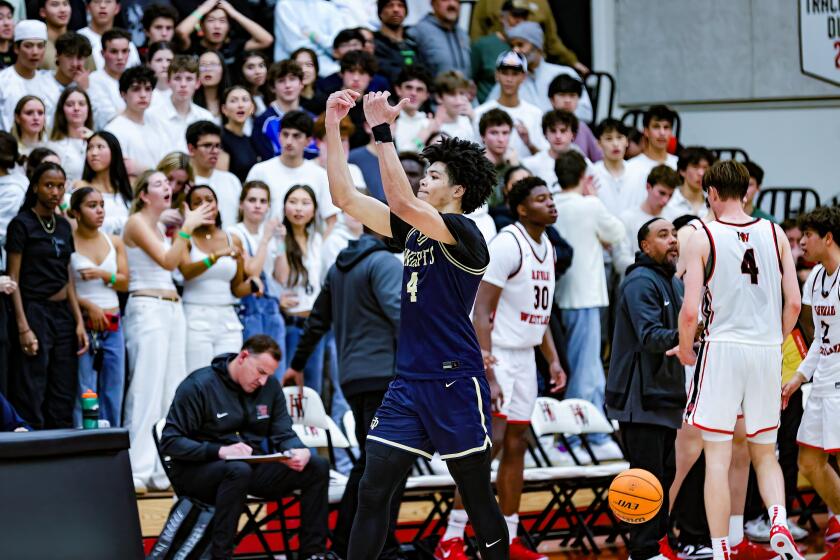Title IX Gap Still Exists 25 Years After Legislation
- Share via
When Peggy Fitzgerald graduated from high school as a standout volleyball player in 1966, an athletic scholarship was out of the question. She was far from the only woman denied a chance to play in college.
“I don’t know of any female athlete in the city who went to school anywhere on any kind of athletic scholarship when I graduated,” she said.
Now, Fitzgerald’s oldest daughter, Meg, is on a volleyball scholarship at Florida and her younger daughter, Elizabeth, hopes to get a scholarship when she graduates from high school in two years.
Twenty-five years after the federal government mandated that women’s sports programs at schools be equitable with men’s, the playing field is not yet level, but Peggy Fitzgerald and many others marvel at the changes.
“I don’t think I even considered playing in college,” said Fitzgerald, who works at New Orleans’ Isidore Newman School, where her husband is the boys’ basketball coach. “It never even occurred to me. I just considered my athletic career over after my senior year in high school.”
Title IX aimed to change that for women.
On June 23, 1972, President Nixon signed the Higher Education Act, which includes Title IX. It banned sex discrimination at schools that get federal funds.
That year, less than $100,000 was spent nationwide on athletic scholarships for women. Now it’s $179 million. From 1971 to 1995, female high school sports participation increased from 294,000 to 2.4 million; college participation for women more than tripled from 31,000 to 110,000.
But for all the progress, women’s athletics still lag far behind men’s.
While women represent half of all students in the nearly 300 division I-A colleges, only 34 percent of the athletes are women, according to an NCAA study released last month.
That same study showed that financing for women’s college athletics rose from an average of $263,000 a year to $663,000 over the last five years. The money spent on men’s sports in that span increased from $1.5 million to more than $2.4 million.
Such a disparity doesn’t sit well with the National Women’s Law Center, which filed complaints this month with the Department of Education’s Office for Civil Rights. It accuses 25 schools, including Vanderbilt, Duke, Wake Forest, Boston College and Brigham Young, of discriminating against women athletes.
Women receive just over one-third of all intercollegiate athletic scholarships, according to the law center.
Moreover, 80 percent or more of colleges are not in compliance with Title IX, according to figures compiled by the Women’s Sports Foundation, a nonprofit group founded in 1974 by Billie Jean King. At high schools, girls make up 50 percent of the students but only 39 percent of the athletic programs are for them, the group said.
The NCAA study also called the gains by women disappointing.
“At this rate, it will take 10 to 12 years to reach proportionality,” executive director Cedric W. Dempsey said. “This is a much slower rate than what we thought was happening.”
Women’s sports faced many obstacles after Title IX went into effect, including early hostility from schools and the NCAA, which sued to try to have the measure declared illegal. Many schools felt Title IX would take away funds from men’s sports and hurt big money-makers, like football and basketball.
Those attitudes have stalled compliance with Title IX.
“If you had substituted race for gender, this would have been done so fast your head would be spinning,” said Nancy Rafuse, a lawyer who represented five women who sued LSU last year. “No one would say this group isn’t interested in sports or that spending money on them would be silly because of their race. People have felt comfortable saying that about women.”
In the face of criticism that Title IX has been loosely enforced, President Clinton is giving every federal agency 90 days to submit to him “a new and vigorous enforcement plan” to strengthen the law’s anti-discrimination punch.
“Too many schools and education programs still drag their feet,” he said Tuesday in marking Title IX’s silver anniversary.
LSU athletic director Joe Dean said schools sometimes have trouble meeting the requirements because they don’t have enough money.
“When you talk about adding sports you have to talk about how to pay for them. I don’t get any money from anybody. We (the athletic department) have to be totally self-supporting,” Dean said. “You have to balance what you need to do with the reality of the costs. That’s not easy and for a lot of schools it’s getting harder all the time.”
Cutting men’s sports has been the answer for many schools.
The NCAA study covering every division from 1991 to 1996, found that while the percentage of women athletes increased 9 percent, the overall number of male athletes decreased between 10 and 12 percent.
Cal State Northridge, saying it must cut expenses and create equal opportunity for women, eliminated four sports, including three of its most popular -- baseball, men’s volleyball and men’s soccer. The move came after the California chapter of the National Organization for Women sued the Cal State University system.
Determination of Title IX compliance is based on a three-prong test under which a college may show that the ratio of female students to male students and female and male athletes is substantially the same. If that is not true, the school may show that it is moving toward compliance and has a plan to reach that goal in a set time. The school may also show that there is no unmet need among the under-represented group.
In a case that attracted national attention last year, Brown University argued that Title IX required quotas rejected by a federal appeals court. The school, supported by scores of other schools and groups, appealed to the U.S. Supreme Court.
The refusal of the high court in April to hear the matter was viewed as a victory by supporters of the law and another step toward gaining full compliance with Title IX.
The real key to equality will be the people who grew up in the 1970s, said Donna Lopiano, executive director of the Women’s Sports Foundation.
“I know exactly when we’ll reach equity,” Lopiano said. “It will happen when the young women who have benefited from it take positions of responsibility, and when men whose daughters want to play refuse to see them pushed aside.”
Sandy Barbour, the athletic director at Tulane University, calls herself a Title IX baby.
“I got to college in 1977 and the guys had total priority of the gym, the locker rooms, the fields,” she said. “During my time in college, Title IX was just starting to take hold.”
Although there were no scholarships at Wake Forest for Barbour, a basketball and field hockey player, she said Title IX opened doors.
“The growth in women’s programs piqued my interest and gave me hope and a reasonable opportunity that there might be a career in athletics for me,” she said.
More to Read
Get our high school sports newsletter
Prep Rally is devoted to the SoCal high school sports experience, bringing you scores, stories and a behind-the-scenes look at what makes prep sports so popular.
You may occasionally receive promotional content from the Los Angeles Times.






